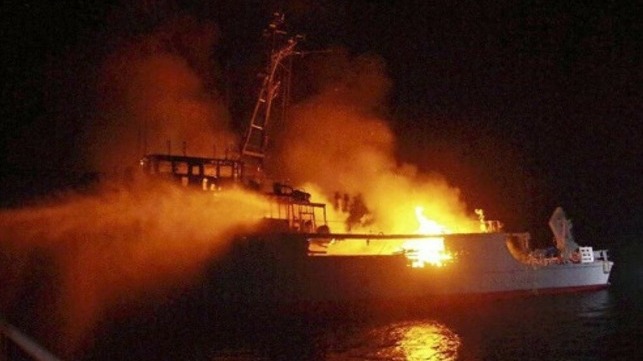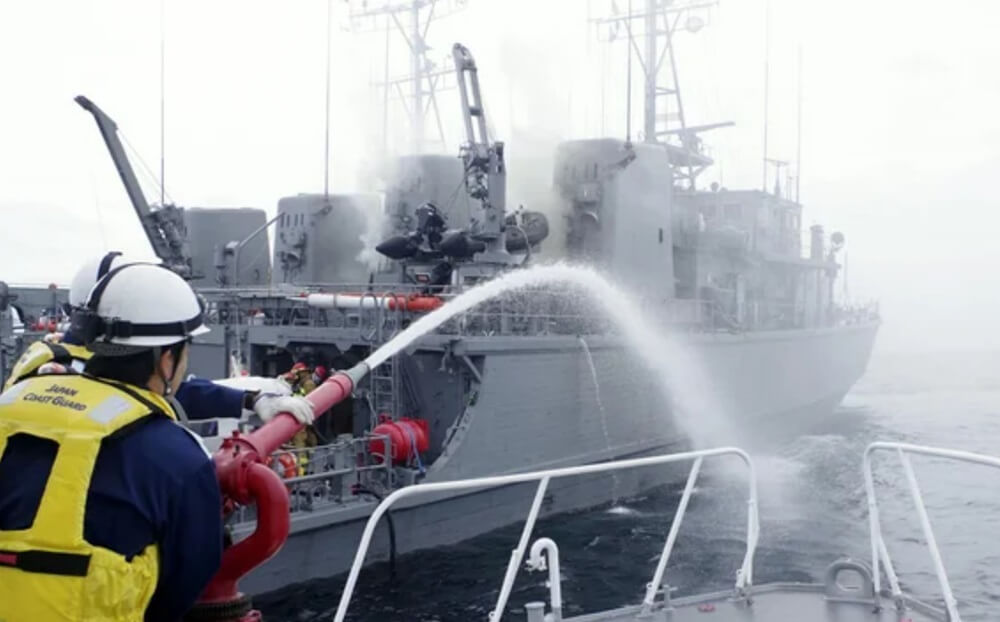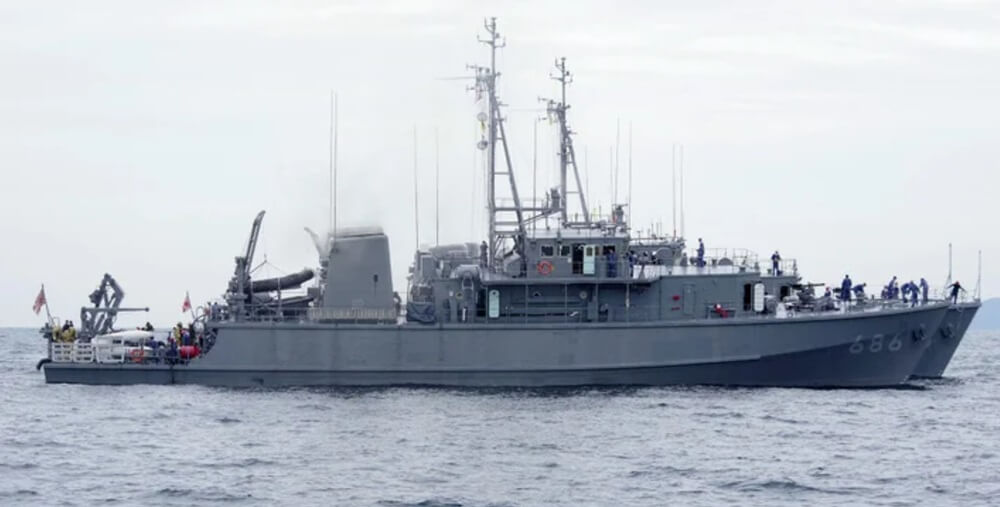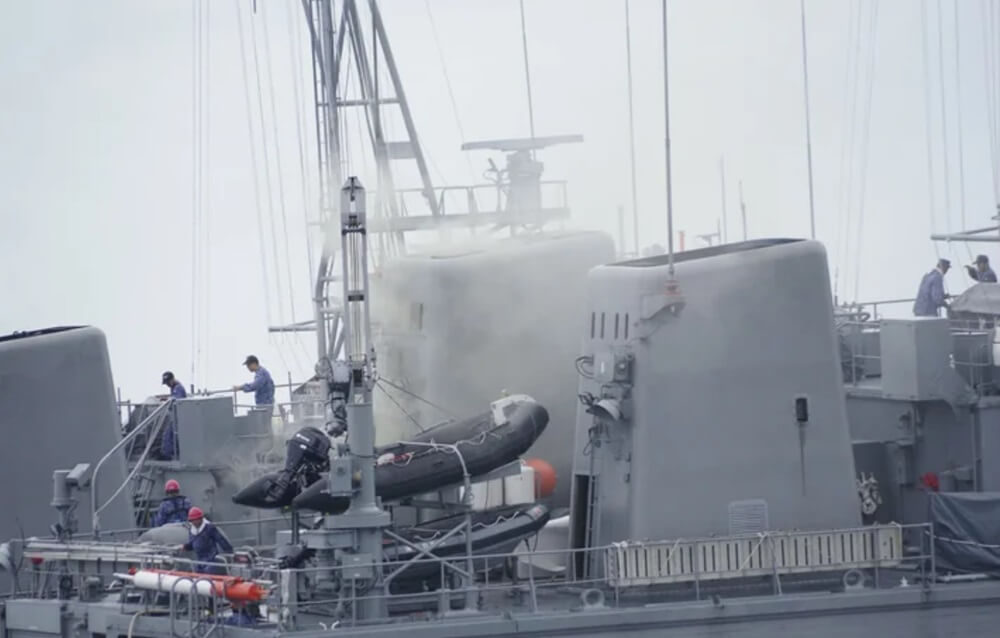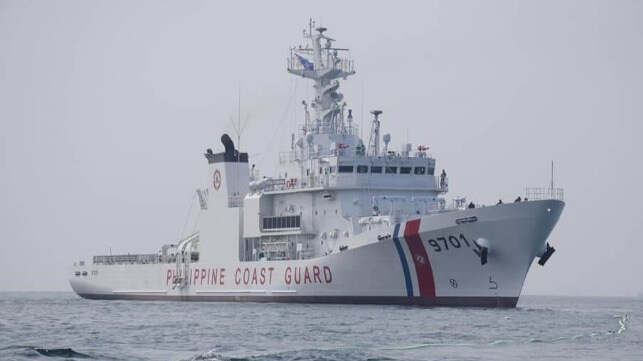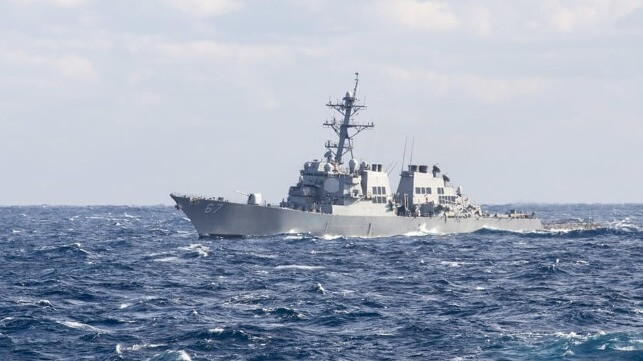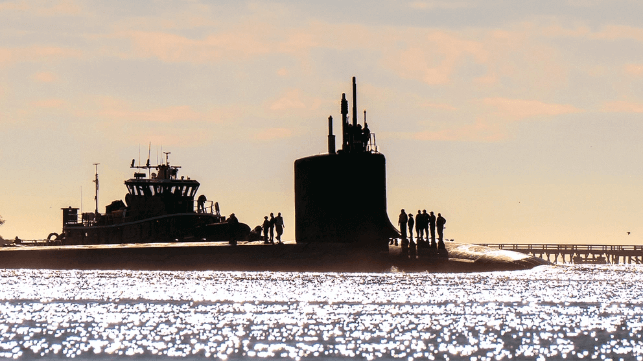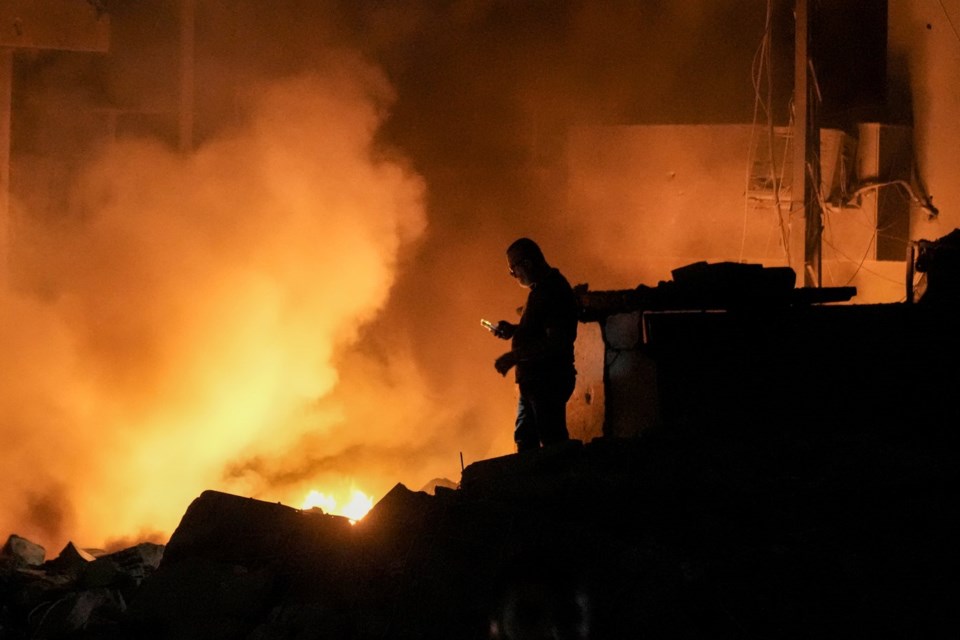BEIRUT (AP) — Israeli airstrikes hit different areas of central Beirut on Thursday evening, killing at least 22 people, Lebanon’s health ministry said, leaving two neighborhoods smoldering and further escalating Israel’s bloody conflict with Iran-bac
BEIRUT (AP) — Israeli airstrikes hit different areas of central Beirut on Thursday evening, killing at least 22 people, Lebanon’s health ministry said, leaving two neighborhoods smoldering and further escalating Israel’s bloody conflict with Iran-backed Hezbollah militants in Lebanon.
The air raid on central Beirut — the deadliest in over a year of war — apparently targeted two residential buildings in separate neighborhoods simultaneously, according to an AP photographer at the scene. It brought down one eight-story building and wiped out the lower floors of the other.
The Israeli military said it was looking into the reported strikes. Israeli airstrikes have been far more common in Beirut’s tightly packed southern suburbs, where Hezbollah bases many of its operations.
After the strikes, Hezbollah’s Al Manar TV reported that an attempt to kill Wafiq Safa, a top security official with the group, had failed. It said that Safa had not been inside of either of the targeted buildings.
Thursday's strikes followed a year of tit-for-tat exchanges between Hezbollah and Israel that boiled over into all-out war in recent weeks, with Israel carrying out waves of heavy strikes across Lebanon and launching a ground invasion. Hezbollah has expanded its rocket fire to more populated areas deeper inside Israel, causing few casualties but disrupting daily life.
The attack came the same day as Israeli forces fired on United Nations peacekeepers in southern Lebanon and wounded two of them, drawing widespread condemnation and prompting Italy's Defense Ministry to summon Israel’s ambassador in protest.
Israeli strikes hit central Beirut
Witnesses reported a large number of ambulances and people gathering in the rubble of two Beirut sites that were hit, in the Ras al-Nabaa neighborhood and Burj Abi Haidar area.
The Lebanese Health Ministry said 22 people were killed and 117 others wounded, without elaborating on their identities. Recent Israeli airstrikes in neighborhoods adjoining Beirut, in particular the densely populated southern suburbs, have killed Hezbollah’s leader, Hassan Nasrallah, and other senior commanders.
Hezbollah began firing rockets into Israel on Oct. 8, 2023, in support of Hamas and the Palestinians, drawing Israeli airstrikes in retaliation.
Hezbollah kept up rocket fire into Israel on Thursday, setting off air raid sirens in parts of northern Israel. Several drones heading toward Israel were intercepted, the military said.
Iran — which supports Hamas, Hezbollah and other armed groups across the region — launched some 180 ballistic missiles at Israel last week in retaliation for the killing of top Hamas and Hezbollah militants.
Israeli Defense Minister Yoav Gallant said Wednesday that its response to the Iranian missile attack will be “lethal” and “surprising,” without providing further details, as Prime Minister Benjamin Netanyahu spoke with President Joe Biden.
Israel’s Channel 12 reported that Israel’s security cabinet would convene Thursday night to discuss the country’s response.
Before the latest Beirut strikes, Lebanon’s crisis response unit said Israeli attacks over the past day had killed 28 people, bringing the total to 2,169 killed in Lebanon since the war erupted last October.
Hezbollah attacks have killed 28 civilians in northern Israel since the war began, as well as 39 Israeli soldiers, both in northern Israel since October 2023 and in southern Lebanon since Israel launched its ground invasion on Sept. 30. Israel says the invasion, so far focused on a narrow strip along the border, aims to push militants back so that tens of thousands of Israelis can return to their homes in the north.
UN peacekeepers caught in intensified fighting in Lebanon
The U.N. peacekeeping mission in Lebanon, known as UNIFIL, said in a statement that its headquarters and positions “have been repeatedly hit" by Israeli forces.
It said an Israeli tank “directly” fired on an observation tower at the force’s headquarters in the town of Naqoura, Lebanon, and that soldiers had attacked a bunker near where peacekeepers were sheltering, damaging vehicles and a communication system. It said an Israeli drone was seen flying to the bunker’s entrance.
The two UNIFIL troops wounded in the attacks and hospitalized are Indonesian, Italy’s Foreign Minister Antonio Tajani said.
The Israeli military acknowledged opening fire at a U.N. base in southern Lebanon on Thursday and said it had ordered the peacekeepers to “remain in protected spaces.”
Later Thursday, the U.N. peacekeeping chief said 300 peacekeepers in frontline positions on southern Lebanon’s border have been temporarily moved to larger bases, and plans to move another 200 will depend on security conditions as the conflict escalates. Jean-Pierre Lacroix told an emergency meeting of the U.N. Security Council that peacekeepers with UNIFIL are staying in their positions, but because of air and ground attacks they cannot conduct patrols.
UNIFIL, which has more than 10,000 peacekeepers from dozens of countries, was created to oversee the withdrawal of Israeli troops from southern Lebanon after Israel’s 1978 invasion. The United Nations expanded its mission following the 2006 war between Israel and Hezbollah, allowing peacekeepers to patrol a buffer zone set up along the border.
Israel accuses Hezbollah of establishing militant infrastructure along the border in violation of the U.N. Security Council resolution that ended the 2006 war.
The European Union’s top diplomat, Josep Borrell, sharply condemned Israeli strikes that hit UNIFIL positions as “an inadmissible act, for which there is no justification.”
From Italy, which has about 1,000 soldiers deployed as part of UNIFIL, Defense Minister Guido Crosetto went further, claimed Israel deliberately targeted the UNIFIL base in southern Lebanon in strikes that “could constitute war crimes.”
Several other countries, including France, Spain and Jordan, also denounced the Israeli attacks.
The U.N. peacekeeping chief, Jean-Pierre Lacroix, said last week that peacekeepers would stay in their positions on Lebanon’s southern border despite Israel’s request to vacate areas before it launched its ground operation against Hezbollah.
Crosetto added: “The U.N. and Italy cannot accept orders from the Israeli government."
Aid group says staff killed in strike on school
Even as attention has shifted to Israel’s close combat with Hezbollah in Lebanon and rising tensions with Iran, Israel has continued to strike at what it says are Palestinian militant targets across the Gaza Strip.
Earlier on Thursday, an Israeli strike on a school sheltering displaced people in central Gaza killed at least 27 people, Palestinian medical officials said. The Israeli military said it targeted Palestinian militants, but people sheltering there said the strike hit a meeting of aid workers.
The dead included a child and seven women, according to the Al-Aqsa Martyrs Hospital, where the bodies were brought. An Associated Press reporter saw ambulances streaming into the hospital and counted the bodies, many of which arrived in pieces.
The Israeli military said it targeted a militant center inside the school, without providing evidence. Israel has repeatedly attacked schools that were turned into shelters in Gaza, accusing militants of taking cover in them.
“There were no militants. There was no Hamas,” said Iftikhar Hamouda, who had fled from northern Gaza earlier in the war.
“We headed to tents. They bombed the tents ... In the streets, they bombed us. In the markets, they bombed us. In the schools, they bombed us,” she said. “Where should we go?”
Israel's offensive in Gaza started after Hamas’ Oct. 7 attack, when militants stormed into Israel, killing some 1,200 people, mostly civilians, and abducting around 250 others.
Israel’s offensive has killed over 42,000 Palestinians, according to local health authorities, who do not specify between militants and civilians. The war has destroyed large areas of Gaza and displaced around 90% of its population of 2.3 million people, often multiple times.
___
Shurafa reported from Deir al-Balah, Gaza Strip, and Magdy reported from Cairo. Edith Lederer contributed from New York.
___
Find more of AP’s coverage at https://apnews.com/hub/israel-hamas-war.
Bilal Hussein, Wafaa Shurafa And Samy Magdy, The Associated Press
Israeli attacks on UN peacekeepers in Lebanon could be 'war crimes,': Italy's defense chief
'These are extremely serious violations of the norms of international law, not justified by any military reason,' says Guido Crosetto
Burak Bir |11.10.2024 -

The 120-kilometer-long Blue Line border between Israel and Lebanon
LONDON
Italy's defense minister said Thursday that Israeli army fire on the positions of UN peacekeepers in Lebanon could be “war crimes,” adding there could be no justification for it.
"The hostile acts carried out and repeated by the Israeli forces could constitute war crimes," Guido Crosetto said at a news conference in Rome.
The United Nations Interim Force in Lebanon (UNIFIL) said earlier that its headquarters in Naqoura and other sites have been repeatedly shelled by Israeli forces, leaving two peacekeepers injured.
Earlier Thursday, Crosetto summoned the Israeli ambassador to Italy because of the "unacceptable" attack.
"These are extremely serious violations of the norms of international law, not justified by any military reason," Crosetto noted, reported by Italian news agency, ANSA.
Crosetto said he told the Israeli ambassador that Italy "cannot take orders from the Israeli government."
Israel has mounted massive airstrikes across Lebanon against what it claims are Hezbollah targets since Sept. 23, killing at least 1,323 people, injuring over 3,700 others, and displacing more than 1.2 million.
The aerial campaign is an escalation in a year of cross-border warfare between Israel and Hezbollah since the start of Tel Aviv’s brutal offensive against the Gaza Strip that has killed more than 42,000 people, mostly women and children, since a Hamas attack last year.
Despite international warnings that the Middle East region was on the brink of a regional war amid Israel’s relentless attacks on Gaza and Lebanon, Tel Aviv expanded the conflict by launching a ground invasion into southern Lebanon on Oct. 1.
UN bases in Lebanon hit by artillery more than 100 times in past year, official says
Israeli forces have asked U.N. peacekeepers to withdraw.
ByDavid Brennan
October 10, 2024

Spanish peacekeepers of the United Nations Interim Force in Lebanon (UNIFIL) coordinate their patrol with -/AFP via Getty Images
ABC News correspondent Patrick Reevell has the latest from the war in the Middle East.
LONDON -- United Nations peacekeeping bases in southern Lebanon have been hit by artillery fire around 100 times since the cross-border war with the Iran-backed Hezbollah militant group began in October 2023, an official with the mission said.
Some of the U.N. bases hit have sustained damage within the compounds, Andrea Tenenti, the spokesperson for the United Nations Interim Force in Lebanon, told ABC News shortly before the mission said two of its peacekeepers were injured by Israeli firing on Thursday.
UNIFIL said in a statement that the IDF fired on three bases in southern Lebanon. The attacks included tank fire on an observation tower at the UNIFIL headquarters in Naqoura which injured two peacekeepers. "Any deliberate attack on peacekeepers is a grave violation of international humanitarian law," UNIFIL said.
The IDF Spokesperson's Unit said in a statement to ABC News that it instructed UNIFIL troops to "remain in protected spaces" during their operation in Naqoura, "following which the forces opened fire in the area." The unit did not comment on the two injured UNIFIL peacekeepers. Danny Danon, Israel's ambassador to the U.N., suggested Thursday that UNIFIL troops should move around 3 miles north from their current positions "to avoid danger as fighting intensifies and while the situation along the Blue Line remains volatile as a result of Hezbollah's aggression."
The security situation is "really concerning" for the 2,000 or so U.N. personnel deployed to the south of the country, Tenenti said, with nearby fighting between Israel Defense Forces and Hezbollah troops near-constant.
U.N. commanders are in contact with both the IDF and Hezbollah, but Tenenti said they do not always receive advance warning of attacks.

An Israeli army tank is transported amid cross-border hostilities between Hezbollah and Israel, in northern Is...Show more
Ammar Awad/Reuters
"We don't always receive information about shelling," he said. "At the moment, it's ongoing. As for the last few days, the level of alert has been very high."
The IDF did not respond to an ABC News' request for comment. IDF spokesperson Rear Adm. Daniel Hagari said this month that Lebanon and UNIFIL have "failed to enforce" a 2006 United Nations Security Council resolution prohibiting Hezbollah's presence in southern Lebanon.
Tenenti said that for the last 48 hours UNIFIL troops have been at their highest of three alert levels. "Level 3 means that you're inside bunkers, you sleep inside the bunkers," he said. "You have to wear protection 24/7, so it's not easy."
Level three reflects "active shelling," he added. "For the last 48 hours, most of the areas in the south of Lebanon in our compounds have been at Level 3."
In Lebanon's no man's land
U.N. troops have been active in Lebanon since 1978, when the U.N. Security Council created UNIFIL to confirm Israel's withdrawal from the area and help Beirut reestablish control.
Since 2006, UNIFIL has been tasked with monitoring the cessation of cross-border hostilities following the last significant cross-border conflict between the IDF and Hezbollah and supporting the planned -- but ultimately unrealized -- Hezbollah withdrawal from the area and the redeployment of the Lebanese Army in its place. That plan was set out by U.N. Security Council resolution 1701.
Israel's nascent military operation into southern Lebanon came after almost a year of cross-border fire. Hezbollah began new attacks on Oct. 8, 2023, in support of Hamas' attack a day earlier in southern Israel.

This combination created on Oct. 9, 2024 of two Planet Labs PBC satellite pictures show the arrival of militar...Show more
-/Planet Labs PBC/AFP via Getty Images
Hezbollah rockets and drones prompted tens of thousands of Israelis to flee border regions. Their safe return has become a prime war goal for Prime Minister Benjamin Netanyahu, his government and his political rivals.
UNIFIL is present at 29 positions within around 3 miles of the Israel-Lebanon border, or "Blue Line." Those positions are manned by around 2,000 troops, with the total UNIFIL in-country strength made up of 10,400 personnel drawn from 50 countries.
Advancing Israeli forces asked UNIFIL troops to abandon their positions, but commanders refused. Tenenti said the requests have stopped, though Israeli officials continue to warn that they cannot guarantee the safety of peacekeepers in the area.
"It's important to have the U.N. flag flying close to the Blue Line and our area of operations," Tenenti said. "But definitely the situation now is way more challenging because of the intensity of the shelling, of the bombing that is not only daily, but continuously."
IDF troops and tanks have been fighting right outside the gates of at least one UNIFIL compound. Israeli forces were "a few meters away" from Irish peacekeepers at the Maroun al-Ras compound in southwest Lebanon this week, Tenenti said.
"I understand that some of the IDF troops left the area close to Maroun al-Ras where the Irish troops are positioned, but it's still a concern for all the other contingents and all the other positions along the line," he said.
Their presence, he added, endangers U.N. troops, undermines UNIFIL's ability to enforce its mission and limits its efforts to assist local communities facing evacuation orders and massive Israeli bombardment.
UNIFIL troops are helping those they can, Tenenti said. "I understand that just now we were able to provide water to some of the villages close to the Blue Line," he said. "We are hoping that this will continue, and not only continue but increase."
UNIFIL is also pressing for "humanitarian corridors" and safe access for the Lebanese Red Cross and U.N. agencies to enter into some of the villages, Tenenti added.
Most U.N. positions are prepared with at least two weeks of supplies, Tenenti said, meaning supply missions through the battlefield are required. "So far, we have been able to resupply all the bases, all the positions, whenever there was a need," he said.
UNIFIL commanders inform both sides of planned supply runs, he added. Sometimes one or both sides will warn against the plans. "But on other occasions, we have no response at all. And that's very dangerous," Tenenti said.
Meanwhile, Israel's ground incursion continues to expand under the cover of punishing air and artillery strikes. The IDF's ultimate goals remain unclear.
"The situation is changing by the minute, and so far, the advance is still not too far from the Blue Line," Tenenti said. "Things are changing very, very fast."
ABC News' Camilla Alcini and Ellie Kaufman contributed to this report.




.jpg)
